Victoria Sadler's Blog, page 18
June 15, 2014
Hilary Mantel's Wolf Hall Takes to the Stage
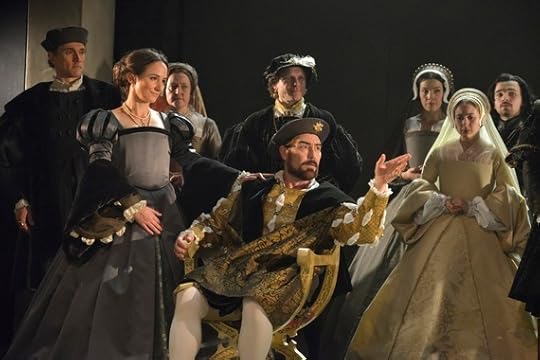
The stage adaptation of Wolf Hall is extraordinary. It's dark, absorbing, full of intrigue and historical detail. Yet it is also pacey, at times even funny. And incredibly it even feels modern and fresh.
Loyal to the novel, Wolf Hall is the story of Thomas Cromwell's tentative steps from observer to manipulator in the court of Henry VIII. As Henry's previously trusted coterie of advisers fluster and flounder in the face of his determination to divorce from Queen Katherine in favour of Anne Boleyn, Henry finds in Cromwell a man who can make bold, difficult decisions.
To translate Hilary Mantel's extraordinary work onto the stage must have been a huge challenge. The result is a resounding success as there is so much to applaud in this quite brilliant production.
In his adaptation of the book, Mike Poulton has created an engaging, absorbing play. Mantel's book is, of course, superb - but it is long and full of detail. Poulton's writing really brings energy to the piece, keeping the plot driving forward.
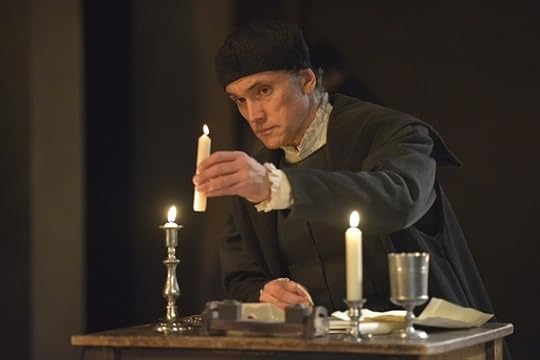
There's a lot of ground to cover in Wolf Hall but never once does this play drag, nor does it feel over-edited. Instead Jeremy Herrin's direction is nimble, weaving its way effortlessly through the plotting and scheming of the courts cliques, across locations, taking in a myriad of characters. There's also a smart use of humour to balance out the drier aspects of court politics.
Herrin must have had a few sleepless nights trying to figure out how to juggle all the many aspects to this play. There are so many themes going on here - religion, class, gender, power versus authority, justice versus the law - yet it all has come together in an engaging blend.
The acting on show is of the highest calibre. These are characters, figures from history, which we all know so well. How do you go about preparing, personifying, such familiar figure as Henry VIII and Anne Boleyn? Credit to every member in this cast as each of them was faultless.
It seems almost unfair to pick actors out from an extraordinary ensemble but special mention must go to Nathaniel Parker, who showed a real deft touch in his portrayal of King Henry VIII as a monarch with such potential slowly, but surely, become corrupted by his power and vanity.
Paul Jesson was also superb as Wolsey, the Cardinal hopelessly outmanoeuvred by events out of his control, and I also thought John Ramm brought a quite moving dignity to his Thomas More.
But there's no doubt that it's Ben Miles as Thomas Cromwell that is the heart and (sinister) soul of this production. The highest compliment I can give him is that it will be a very tough race between him and Mark Strong (for A View from the Bridge) for Best Actor come awards season.
As Cromwell is an observer for much of this part of the story, Miles had a real challenge in creating a character that is engaging, that the audience feels drawn to. Miles achieved that in spades, using a rather dry, acerbic wit to make Cromwell likeable, as well demonstrating a profound loyalty to those who have supported him, and to those he considers family.
But there were also surprises in this production.
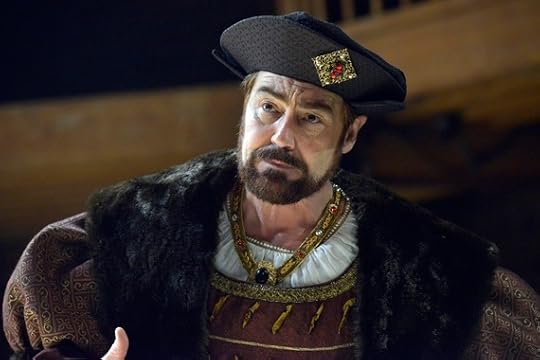
Set in a Tudor court, I came with expectations on what the set design would be. Expecting the traditional fair of dark wood, rich colours and heavy tapestries, I was blown away with the simple but incredibly clever set design from Christopher Oram (who impressed so much with his sets for the recent Michael Grandage season).
The backdrop is bare, stark - except for a large cross cut into it. Ambiguously it could be either the bare cross of the new protestant religion or it could be the cross of St George. I expect it is both - a beautifully, ominous shadow of how this complex intertwining of country and religion will be cleaved apart by the story taking place in front of it.
Wolf Hall has the perfect blend of character and plot. It is dark, scheming and it will grab you and absorb you till the very end.
The play's run has recently been extended to October. Given that much of the original run sold out, I urge you to get tickets soon for the new dates. You will not be disappointed.
Aldwych Theatre, London to October 4, 2014
Image credits:
1. Ben Miles, Lydia Leonard, Lucy Briers, Oscar Pearce, Nathaniel Parker, Madeleine Hyland, Leah Brotherhead Pierro Niel Mee. Photographer Keith Pattison.
2. Ben Miles (Thomas Cromwell). Photographer Keith Pattison.
3. Nathaniel Parker (Henry VIII). Photographer Keith Pattison.
Published on June 15, 2014 08:33
June 12, 2014
It's Time to do Something About the Gender Pay Gap
You know how you're not allowed to talk about your salary with your work colleagues? Why do you think that is? Because, let's be honest, that secrecy only ever benefits the employer, not the employee.
Personally, I've long been of the belief that pay confidentiality masks and enables gender discrimination, irrelevant of the requirements of the Equal Pay Act. And this week, recent figures were published that backs that fear up.
The magazine Grazia revealed that the gender pay gap between men and women in their twenties had doubled in the past three years. Doubled. That's a phenomenal jump at a time when we're supposedly making great strides against sexism in many high-profile campaigns.
The figures come from the Office of National Statistics and their Annual Survey of Hours and Incomes. The ONS Survey showed that the pay gap between men and women has leapt from 2.6% to 5.3% since 2010.
And for women in their thirties, like me, it's gone from 11.9% to 12%. Not a massive change you might think but all I'm thinking is WHAT THE HELL??!! That's a WHOPPING gap. And it's not coming down.
Now I'm pretty touchy about this not only because me being paid less than a man on the basis of gender is discriminatory and illegal, but also because I know for a fact that I've been a victim of pay discrimination simply because of my gender.
I used to work in investment banking (we all make mistakes) so you might think that gender discrimination was just in the air in that place. And in many ways you'd be right. But I always figured that given the amount of bad publicity banks got for their treatment of women, they'd go out of their way to avoid courting trouble by ensuring that pay was equal.
Turns out I was wrong.
Life in the City is all about bonus season but one year, after coming out from finding out his bonus and salary increase, a male colleague, Jake, told me his numbers.
It should've been an inconsequential disclosure but when I was called in to see Ryan, the Head of my department, to receive my numbers, a confrontation ensued, as this excerpt from my memoir of life in the City, Banking on Burlesque shows:
"We'd love to give you more but obviously there isn't much to go round. However the very good pay rise and sizeable bonus we've given shows how highly..."
 Ryan was talking but I wasn't listening. I was completely fixated with the numbers on the piece of paper in front of me. They were different from Jake's. They were both lower. Not by much, a couple of grand on each, but they were lower.
 Ryan was still on his sales pitch but I wasn't interested. "Why are these numbers different from Jake's?"
 "What?"
 "These numbers, both of them, they're both lower than Jake's. Why is that?"
 Ryan looked at me, his jaw tight.
 I went on. "Why are these numbers lower than Jake's? We are at an
identical level and we have the same performance so therefore we should both be on the same pay but we're not. He's being paid more than me, in both salary and bonus."
 "Jake shouldn't have told you his numbers."
 "I know that but he did because he thought mine would be identical and he didn't think anything of it. Nor did I. Why are you paying him more than me?"
 Ryan's jaw remained tight. I was on dangerous territory here and I knew it.
 "What are you saying?" he asked.
 "I'm asking why you're paying a male colleague, who has not demonstrated superior performance to me, more than me."
 Ryan said nothing.
 "Ryan, if you won't pay me what I'm worth, I will find someone who will."
 "You shouldn't make empty threats Victoria."
 I lifted my chin slightly. "I'm not."
And this was no empty threat. I handed in my resignation. My boss Ryan offered me far more money to stay, more money than what Jake was being paid - clear evidence that my pay discrimination could not be justified. But I left anyway.
I got 'lucky' in that a male colleague was transparent with me. But that's a rare situation. To address this, Grazia has launched a campaign to make companies publish the details of hourly pay for male and female employees.
In order to effect change, Grazia is looking to an unenforced piece of legislation from the last Labour government to be enacted, which would enforce transparency
Section 78 of the Equality Act 2010 requires big employers i.e. those with more than 250 staff, to publish details annually on the hourly pay of their male employees compared to their female.
This legislation was shelved at the time but now Grazia has started a petition for it to be enforced. If it were, and you worked in a big company like I did, you'd be able to see if you are being paid less than your male colleagues who are in comparable roles.
And nothing would force the hand of employers quicker than transparency, as it did in my case. And the threat of legal action that would come off the back of perpetuating unequal pay could transform this imbalance for good.
So to sign Grazia's petition, head here.
Victoria's memoir Banking on Burlesque is available on Amazon here.
Personally, I've long been of the belief that pay confidentiality masks and enables gender discrimination, irrelevant of the requirements of the Equal Pay Act. And this week, recent figures were published that backs that fear up.
The magazine Grazia revealed that the gender pay gap between men and women in their twenties had doubled in the past three years. Doubled. That's a phenomenal jump at a time when we're supposedly making great strides against sexism in many high-profile campaigns.
The figures come from the Office of National Statistics and their Annual Survey of Hours and Incomes. The ONS Survey showed that the pay gap between men and women has leapt from 2.6% to 5.3% since 2010.
And for women in their thirties, like me, it's gone from 11.9% to 12%. Not a massive change you might think but all I'm thinking is WHAT THE HELL??!! That's a WHOPPING gap. And it's not coming down.
Now I'm pretty touchy about this not only because me being paid less than a man on the basis of gender is discriminatory and illegal, but also because I know for a fact that I've been a victim of pay discrimination simply because of my gender.
I used to work in investment banking (we all make mistakes) so you might think that gender discrimination was just in the air in that place. And in many ways you'd be right. But I always figured that given the amount of bad publicity banks got for their treatment of women, they'd go out of their way to avoid courting trouble by ensuring that pay was equal.
Turns out I was wrong.
Life in the City is all about bonus season but one year, after coming out from finding out his bonus and salary increase, a male colleague, Jake, told me his numbers.
It should've been an inconsequential disclosure but when I was called in to see Ryan, the Head of my department, to receive my numbers, a confrontation ensued, as this excerpt from my memoir of life in the City, Banking on Burlesque shows:
"We'd love to give you more but obviously there isn't much to go round. However the very good pay rise and sizeable bonus we've given shows how highly..."
 Ryan was talking but I wasn't listening. I was completely fixated with the numbers on the piece of paper in front of me. They were different from Jake's. They were both lower. Not by much, a couple of grand on each, but they were lower.
 Ryan was still on his sales pitch but I wasn't interested. "Why are these numbers different from Jake's?"
 "What?"
 "These numbers, both of them, they're both lower than Jake's. Why is that?"
 Ryan looked at me, his jaw tight.
 I went on. "Why are these numbers lower than Jake's? We are at an
identical level and we have the same performance so therefore we should both be on the same pay but we're not. He's being paid more than me, in both salary and bonus."
 "Jake shouldn't have told you his numbers."
 "I know that but he did because he thought mine would be identical and he didn't think anything of it. Nor did I. Why are you paying him more than me?"
 Ryan's jaw remained tight. I was on dangerous territory here and I knew it.
 "What are you saying?" he asked.
 "I'm asking why you're paying a male colleague, who has not demonstrated superior performance to me, more than me."
 Ryan said nothing.
 "Ryan, if you won't pay me what I'm worth, I will find someone who will."
 "You shouldn't make empty threats Victoria."
 I lifted my chin slightly. "I'm not."
And this was no empty threat. I handed in my resignation. My boss Ryan offered me far more money to stay, more money than what Jake was being paid - clear evidence that my pay discrimination could not be justified. But I left anyway.
I got 'lucky' in that a male colleague was transparent with me. But that's a rare situation. To address this, Grazia has launched a campaign to make companies publish the details of hourly pay for male and female employees.
In order to effect change, Grazia is looking to an unenforced piece of legislation from the last Labour government to be enacted, which would enforce transparency
Section 78 of the Equality Act 2010 requires big employers i.e. those with more than 250 staff, to publish details annually on the hourly pay of their male employees compared to their female.
This legislation was shelved at the time but now Grazia has started a petition for it to be enforced. If it were, and you worked in a big company like I did, you'd be able to see if you are being paid less than your male colleagues who are in comparable roles.
And nothing would force the hand of employers quicker than transparency, as it did in my case. And the threat of legal action that would come off the back of perpetuating unequal pay could transform this imbalance for good.
So to sign Grazia's petition, head here.
Victoria's memoir Banking on Burlesque is available on Amazon here.
Published on June 12, 2014 05:40
June 8, 2014
Made in Mexico Exhibition, Fashion and Textile Museum

The Fashion and Textile Museum is hosting the first-ever exhibition on the rebozo - the classic Mexican shawl made famous in 20th century culture by artist Frida Kahlo.
This exhibition explores the key role rebozos have played in promoting Mexican culture worldwide from the 17th century to the present day.
Rebozos lie at the heart of Mexican life and they are a part of every stage of the journey from birth through childhood, courtship, marriage, death and mourning.
They are huge pieces of fabric. Heavily patterned, brightly coloured - the variety in style amongst them tends to reflect the preferences of the local community which makes them - but all are finished with fringing from the simple to the heavily embellished.
The rebozos are made through traditional looms by artisans in regional communities using skills that have been passed down through the generations. As examples, the Museum has brought together an extraordinary collection of rebozos, some over 100 years old.
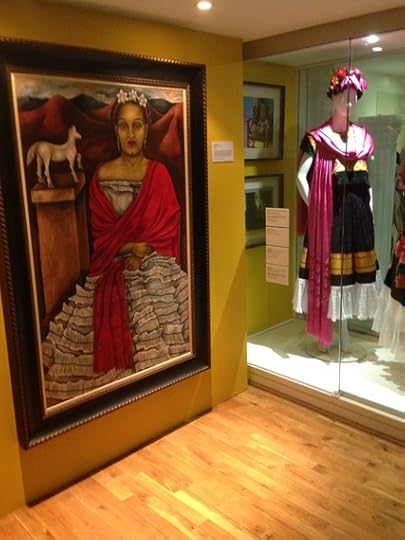
Historic rebozos from the Franz Mayer Museum, Mexico City, have been reunited with impressive loans from the British Museum - garments from the Robert Everts Collection (Everts was an English diplomat in Mexico at the beginning of the 20th century and he recognised their importance, making some impressive purchases).
The exhibition is very well curated, with this ubiquitous presence of rebozos across the social classes and through all stages in life really brought out through the use of photography and paintings from contemporary Mexican artists.
Artwork from greats such as Graciela Iturbide (who recently had a display at the Tate Modern), Pedro Diego Alarado and Fransico Toledo complement the garments superbly and reflect the rebozos in use throughout the Mexican community.
The Museum also commissioned works from popular contemporary Mexican fashion designers such as Carmen Rion and Carla Fernandez to present their response to the rebozo and these are also on display, along with a unique piece from Zandra Rhodes, the founder of the Museum.
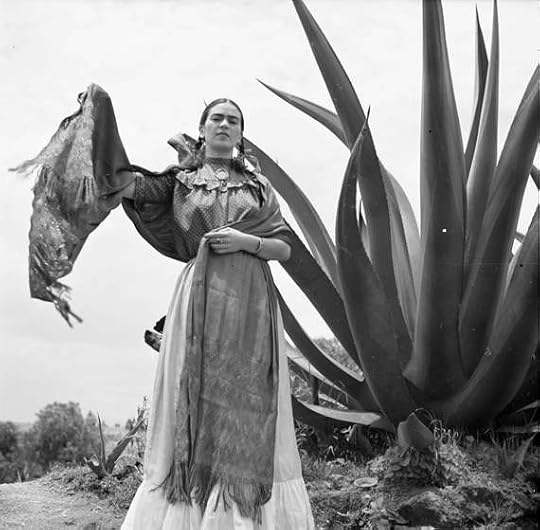
Of course the most famous proponent of the rebozo, to Western eyes, was Frida Kahlo and she is well-represented at the exhibition. She wore the rebozo as a symbol of Mexican identity, a trend continued today by Lila Downs, the Grammy-award winning artist who also wears the traditional garment.
The Fashion and Textile Museum is the perfect venue for this exhibition as its building is the only one in Europe designed by award-winning Mexican architect Ricardo Legorreta. And internally, with its brightly coloured walls - pinks, yellows - it's the perfect backdrop.
To create a rebozo is a labour-intensive process, and one which requires knowledge of traditional production methods. The Museum brings this out in great detail with details on the various stages such as winding, placing the threads, soaking and weaving.
Not only is this crucially informative but gives you such respect for the garments on show.
Sadly, with the advent of globalisation and the lack of support for traditional crafts, there are fears that the necessary skills to create rebozos will be lost. If the rebozo really is to survive and thrive as a symbol of Mexican identity, it will need support to do so.
Throughout the run of the exhibition, the museum is also hosting events on a variety of aspects of the subject matter, including a talk on Frida Kahlo and the rebozo, an evening of Mexican Festival mask making, and a workshop to create your own Day of the Dead appliqué shopping bag.
After this exhibition closes in London it travels to the Franz Mayer Museum in Mexico City, where it will open in Spring 2015.
Fashion and Textile Museum, London to August 31, 2014
Admission £8 (concessions available)
Image credits:
1. Lila Downs, Grammy award-winning musician, wearing a rebozo de pluma from Ahuiran, Michoacán Antonio Turok, Summer 2013 Photograph © Antonio Turok
2. Installation image from exhibition © Victoria Sadler
3. Frida Kahlo with Rebozo Toni Frissell, 1937 Part of a series published in US Vogue Photograph © The Frissell Collection, Library of Congress
Victoria Sadler's debut novel Banking on Burlesque now available on Amazon.
Published on June 08, 2014 11:40
June 6, 2014
Alan Turing: 60 Years On
Saturday 7 June marks the 60th anniversary of Alan Turing's untimely death at only 41 years of age. Though he was a genius and a national hero, he is sadly still not a household name.
This is partly because much of Turing's work was top secret, withheld from public knowledge for decades by the Official Secrets Act. But also because much of what we know about Turing has been defined by the circumstances of the man's tragic death.
Turing committed suicide in 1954 - cyanide poisoning from an apple he had deliberately contaminated - widely seen as the result of his conviction in 1952 of indecency (Turing was gay) and the punitive course of chemical castration he was inflicted with as punishment for his 'crime.'
But though Turing was unquestionably a victim of a terrible and discriminatory law, it's important that we recognise the man's genius, praise him for what he achieved when he was alive and realise why this man's early death was such a loss for us all.
A bit of a mathematical prodigy, Alan Turing first caught the attention of the science community after he wrote a paper called "On Computable Numbers." In this paper, Turing set out conceptually what a computer would be and how it would work.
Sounds impressive enough. But this paper was published in 1936, way, way before the mass production of computers, let alone the internet. It was ahead of its time by decades. And Alan Turing was only 24.
In his paper, Alan introduced two concepts - the "algorithim" and "computing machines." Our world is dominated by these now but back in 1936 this was revolutionary. And such was the brilliance in the paper that it has become the standard definition of computability and would also become the bedrock of artificial intelligence.
Alan believed that computers could learn, that an electronic brain could be created and that this could take on more knowledge than the human brain was capable of, and that it could therefore solve problems that the human brain simply could not even compute. Hence the concept of algorithims.
It was this pioneering work that led to his call up in 1939 to work for GCHQ at Bletchley Park. His task? Create a method, a program, which could crack Enigma - the naval codes being used by the Nazis to wreak terrible damage on the British and Allied fleets.
It is not an exaggeration to say that had these codes not been cracked, Britain may well have lost the war. At least, the country would most certainly have been invaded. As the historian and wartime code-breaker Asa Briggs has said, "You needed exceptional talent, you needed genius at Bletchley and Turing was that genius."
Within three months, Turing had revolutionised the bombe machines that were being used for this work - and he had cracked the code.
There have been whispers from some that perhaps Turing's role has been overrated, that there was more good fortune and luck in the breaking of the enigma code than the public is being led to believe.
Well, there were mistakes made by the Germans, that's true. But opportunities mean nothing unless you're in a place to exploit them and Turing's automation of the process was so profound that it slashed decryption times and removed all guesswork and trial and error. And secondly, there was so much more to Turing's talent than 'just' cracking enigma.
However, such was the value of Turing's work at Bletchley that it was kept secret by the Official Secrets Act, with his major papers only released in 2012. A reflection of his importance, for sure but it was this secrecy that made life so difficult for Turing after the war. Had the public known this man's crucial role, perhaps things would have worked out very differently.
As required, Turing spoke to no-one about the work he had done for GCHQ but after the war ended, he also struggled to find purpose in his life and his work.
No doubt it was hard to find work as meaningful and fulfilling as the work at Bletchley, but his struggles were probably also exacerbated by an inability to talk to anyone about the work he had completed during the Second World War.
But after he accepted a readership at the University of Manchester in 1948, his work became more fruitful.
Turing was committed to the idea that a computer could learn, could be educated to interact with humans rather than simply be a process-driven tool that executed calculations as directed. He built on his pre-war work on artificial intelligence with a paper in 1950 titled, "Computing Machinery and Intelligence," which opens with the words: "I propose to consider the question, 'Can machines think?"
In this paper, Turing put forward that rather than building a program to simulate the adult mind, it would be better rather to produce a simpler one to simulate a child's mind and then to subject it to a course of education. The results of this pioneering paper we see every day on social media where our computers do interact with us and they do learn.
You know when iTunes and Amazon look at what you've bought and make suggestions on what else you might like? That's based on Turing's work. And when Facebook and Twitter look at who you follow and what you chat about before sending you prompts on conversations and people you might like to follow? Yup, that's Turing too.
And also the reverse is true.The Turing test was reversed by computer scientists to create captchas so that computer programs could tell the difference between computers and people. So, yes, unfortunately you can thank Turing too every time you have to sit there and figure out one of those images.
In 1999, Time Magazine named Turing as one of the 100 Most Important People of the 20th century and stated: "The fact remains that everyone who taps at a keyboard, opening a spreadsheet or a word-processing program, is working on an incarnation of a Turing machine."
Turing was blessed and cursed with one of those extraordinary minds that comes along maybe once or twice in every generation, where a person's capacity for thought is not limited by the world they exist in, but where any and every eventuality is a possibility.
Incredibly Turing was only 38 in 1950, when he wrote that paper. A staggering thought.
But Turing lost his focus, perhaps frustrated with the lack of opportunity and resources to put his method to the test. Or maybe he was becoming increasingly lost generally.
Instead he turned to morphogenesis (the theory that looks at what causes an organism to take its particular shape) rekindling a childhood fascination with biology. In 1952 he published a paper on his work.
Again pioneering, the paper ( The Chemical Basis of Morphogenesis ) served as a basic model in theoretical biology. Some have gone further, claiming it to be the origin of chaos theory.
But we will never know what this incredible brain could have come up with next as only weeks before this paper was published, Turing was convicted and required to start the harrowing process of chemical castration. Two years later, traumatised and alone, Turing committed suicide.
Turing was pardoned on Christmas Eve last year following a high-profile four-year campaign. The length of the campaign gives you some indication of how hard the establishment resisted these attempts.
I wrote about the pardon last year, about how though it was way too late for Turing (and almost insulting in its delay) it was important for the gay community and should have been a stepping stone for the full pardon of every man convicted under that terrible law.
There was talk of more endeavours to raise Turing's profile at the time. I remember an e-petition to get Turing on the £10 note but I don't know if anything came of that. There are rumours that the Apple logo, with a bite taken out of it, was inspired by Turing but it seems that is (sadly) apocryphal.
Token memorials are creeping out slowly - the obligatory blue plaques can now be found on the place of his birth in Warrington Crescent, London and on the house in which he died in Wilmslow.
And there is a bronze statue at the University of Surrey in Guildford, the town where he spent most of his childhood, and the rather sad statue in Sackville Park, Manchester, of Turing sitting on a park bench holding an apple (noticeably paid for through donations rather than public funds).
A plaque at the statue's feet says "Father of computer science, mathematician, logician, wartime codebreaker, victim of prejudice." And all of that is true.
We should be doing more. I know there have been temporary exhibitions and I know there is a high-profile movie coming out but it's a travesty that so few know of this man and his work. We should be educating every kid in school about Alan Turing. Maybe then we can find the next one.
This is partly because much of Turing's work was top secret, withheld from public knowledge for decades by the Official Secrets Act. But also because much of what we know about Turing has been defined by the circumstances of the man's tragic death.
Turing committed suicide in 1954 - cyanide poisoning from an apple he had deliberately contaminated - widely seen as the result of his conviction in 1952 of indecency (Turing was gay) and the punitive course of chemical castration he was inflicted with as punishment for his 'crime.'
But though Turing was unquestionably a victim of a terrible and discriminatory law, it's important that we recognise the man's genius, praise him for what he achieved when he was alive and realise why this man's early death was such a loss for us all.
A bit of a mathematical prodigy, Alan Turing first caught the attention of the science community after he wrote a paper called "On Computable Numbers." In this paper, Turing set out conceptually what a computer would be and how it would work.
Sounds impressive enough. But this paper was published in 1936, way, way before the mass production of computers, let alone the internet. It was ahead of its time by decades. And Alan Turing was only 24.
In his paper, Alan introduced two concepts - the "algorithim" and "computing machines." Our world is dominated by these now but back in 1936 this was revolutionary. And such was the brilliance in the paper that it has become the standard definition of computability and would also become the bedrock of artificial intelligence.
Alan believed that computers could learn, that an electronic brain could be created and that this could take on more knowledge than the human brain was capable of, and that it could therefore solve problems that the human brain simply could not even compute. Hence the concept of algorithims.
It was this pioneering work that led to his call up in 1939 to work for GCHQ at Bletchley Park. His task? Create a method, a program, which could crack Enigma - the naval codes being used by the Nazis to wreak terrible damage on the British and Allied fleets.
It is not an exaggeration to say that had these codes not been cracked, Britain may well have lost the war. At least, the country would most certainly have been invaded. As the historian and wartime code-breaker Asa Briggs has said, "You needed exceptional talent, you needed genius at Bletchley and Turing was that genius."
Within three months, Turing had revolutionised the bombe machines that were being used for this work - and he had cracked the code.
There have been whispers from some that perhaps Turing's role has been overrated, that there was more good fortune and luck in the breaking of the enigma code than the public is being led to believe.
Well, there were mistakes made by the Germans, that's true. But opportunities mean nothing unless you're in a place to exploit them and Turing's automation of the process was so profound that it slashed decryption times and removed all guesswork and trial and error. And secondly, there was so much more to Turing's talent than 'just' cracking enigma.
However, such was the value of Turing's work at Bletchley that it was kept secret by the Official Secrets Act, with his major papers only released in 2012. A reflection of his importance, for sure but it was this secrecy that made life so difficult for Turing after the war. Had the public known this man's crucial role, perhaps things would have worked out very differently.
As required, Turing spoke to no-one about the work he had done for GCHQ but after the war ended, he also struggled to find purpose in his life and his work.
No doubt it was hard to find work as meaningful and fulfilling as the work at Bletchley, but his struggles were probably also exacerbated by an inability to talk to anyone about the work he had completed during the Second World War.
But after he accepted a readership at the University of Manchester in 1948, his work became more fruitful.
Turing was committed to the idea that a computer could learn, could be educated to interact with humans rather than simply be a process-driven tool that executed calculations as directed. He built on his pre-war work on artificial intelligence with a paper in 1950 titled, "Computing Machinery and Intelligence," which opens with the words: "I propose to consider the question, 'Can machines think?"
In this paper, Turing put forward that rather than building a program to simulate the adult mind, it would be better rather to produce a simpler one to simulate a child's mind and then to subject it to a course of education. The results of this pioneering paper we see every day on social media where our computers do interact with us and they do learn.
You know when iTunes and Amazon look at what you've bought and make suggestions on what else you might like? That's based on Turing's work. And when Facebook and Twitter look at who you follow and what you chat about before sending you prompts on conversations and people you might like to follow? Yup, that's Turing too.
And also the reverse is true.The Turing test was reversed by computer scientists to create captchas so that computer programs could tell the difference between computers and people. So, yes, unfortunately you can thank Turing too every time you have to sit there and figure out one of those images.
In 1999, Time Magazine named Turing as one of the 100 Most Important People of the 20th century and stated: "The fact remains that everyone who taps at a keyboard, opening a spreadsheet or a word-processing program, is working on an incarnation of a Turing machine."
Turing was blessed and cursed with one of those extraordinary minds that comes along maybe once or twice in every generation, where a person's capacity for thought is not limited by the world they exist in, but where any and every eventuality is a possibility.
Incredibly Turing was only 38 in 1950, when he wrote that paper. A staggering thought.
But Turing lost his focus, perhaps frustrated with the lack of opportunity and resources to put his method to the test. Or maybe he was becoming increasingly lost generally.
Instead he turned to morphogenesis (the theory that looks at what causes an organism to take its particular shape) rekindling a childhood fascination with biology. In 1952 he published a paper on his work.
Again pioneering, the paper ( The Chemical Basis of Morphogenesis ) served as a basic model in theoretical biology. Some have gone further, claiming it to be the origin of chaos theory.
But we will never know what this incredible brain could have come up with next as only weeks before this paper was published, Turing was convicted and required to start the harrowing process of chemical castration. Two years later, traumatised and alone, Turing committed suicide.
Turing was pardoned on Christmas Eve last year following a high-profile four-year campaign. The length of the campaign gives you some indication of how hard the establishment resisted these attempts.
I wrote about the pardon last year, about how though it was way too late for Turing (and almost insulting in its delay) it was important for the gay community and should have been a stepping stone for the full pardon of every man convicted under that terrible law.
There was talk of more endeavours to raise Turing's profile at the time. I remember an e-petition to get Turing on the £10 note but I don't know if anything came of that. There are rumours that the Apple logo, with a bite taken out of it, was inspired by Turing but it seems that is (sadly) apocryphal.
Token memorials are creeping out slowly - the obligatory blue plaques can now be found on the place of his birth in Warrington Crescent, London and on the house in which he died in Wilmslow.
And there is a bronze statue at the University of Surrey in Guildford, the town where he spent most of his childhood, and the rather sad statue in Sackville Park, Manchester, of Turing sitting on a park bench holding an apple (noticeably paid for through donations rather than public funds).
A plaque at the statue's feet says "Father of computer science, mathematician, logician, wartime codebreaker, victim of prejudice." And all of that is true.
We should be doing more. I know there have been temporary exhibitions and I know there is a high-profile movie coming out but it's a travesty that so few know of this man and his work. We should be educating every kid in school about Alan Turing. Maybe then we can find the next one.
Published on June 06, 2014 16:00
June 4, 2014
Theatre Review: Kevin Spacey Stars in Clarence Darrow
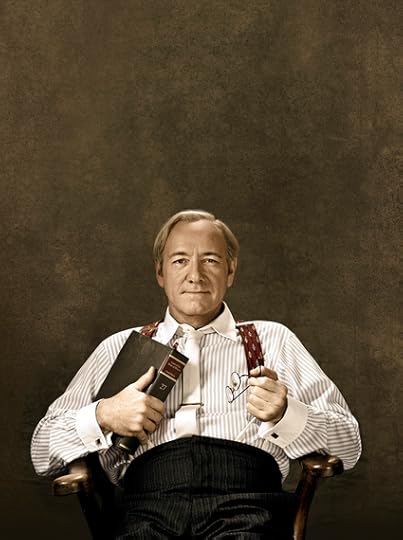
Clarence Darrow is a very passionate, moving play on the experiences and motivations of a famous US union and civil rights lawyer who played a key part in some of the most contested legal fights in the late 19th and early 20th centuries.
In this play, an older Darrow (Kevin Spacey) is packing up his office, reflecting on his life, experiences and the choices that he made as he puts the papers and memorabilia of his past into boxes.
"I've never been sure I made the right choice" Darrow confides. And indeed, for though Darrow was a man who dedicated his life to a higher cause, to the pursuit of justice for all men, this brought with it almost inevitable consequences for his personal life - and repercussions from taking on the powerful.
Darrow was clearly an admirable man but it is Kevin Spacey as much as Darrow who shines in this one-man show.
Spacey's performance felt like an acting masterclass. Every intonation, each deliberate emphasis was such an interesting approach to the text. As Darrow recanted the dark times and the complex legal processes, Spacey's use of both drama and humour brought more from the text, enabling the audience to remain connected with the story being told.
The physical transformation was also obvious with Darrow hunched over and tired, tell-tale signs of a man at the end of a long career of pouring over legal texts and weary from battle.
This isn't the first time Kevin Spacey has played Clarence Darrow - he played the character in a TV series in 1991 (Darrow) and in Inherit the Wind at the Old Vic in 2009. I saw neither of these but there's something very honourable about Spacey's dedication to giving a voice, shining a light, on these unsung heroes from our past, especially as this piece is not without its challenges.
A two hour monologue is always going to be tough and there are passages which are quite dry, particularly in the first half as Darrow recants his early beginnings with his representation of railroad workers and union members.
It's hard for a largely British audience to connect completely with this. Perhaps an American audience would find this easier to follow as they are likely to be more familiar with the Haymarket anarchists, the Chicago riots and these other key events that Darrow became involved with.
But this gets easier in the second half as we move into more familiar territory and Darrow's civil rights work and battles with religious fanaticism. "We are full of prejudices. But we are not born prejudiced" he cries, pleading with us to confront the education of the next generation.
How sad it is that these pleas should resonate with us today, especially given the recent European elections which saw sweeping gains for extremist parties across Europe, and increasing concerns on fanaticism in many religions.
Spacey works hard to keep the audience engaged and with the Old Vic configured in the round, this gives him both opportunities and challenges. The result is a very physical performance from Spacey, as well as an emotional one.
Having the audience so close enables him to reach out and include them in his performance, but it also means he is constantly moving, almost restless on stage, as he looks to ensure every audience member is fully involved and moved by this story.
I imagine Spacey must be quite shattered after each performance but on stage, he handles these challenges so well.
That Spacey is one of the finest actors around I knew before I entered the theatre but his star power was clearly evident in the demographic of the audience. The night I went, the auditorium was filled to capacity with people who confessed they rarely attended theatre, if ever. Some had travelled from across the UK just to see him perform. A couple next to me had travelled from Spain.
Theatre needs new blood in its audiences to survive and thrive, so I found it a telling reminder of why theatre desperately needs its brightest stars to remain committed. They are key to bringing in these audiences.
The play is only on for a limited time as Kevin Spacey is squeezing this in around filming for House of Cards Season 3. It's therefore no surprise that the run has already sold out but there will be 20 Day Seats at £10 for each performance available in person at the Box Office from 10am on the day of the performance.
If you are lucky enough to get a ticket, you will be rewarded with seeing one of the greats very much at the height of his powers.
Old Vic Theatre, London to June 15, 2014
Image credits: Kevin Spacey as Clarence Darrow © Jay Brooks
Published on June 04, 2014 14:00
May 28, 2014
Theatre Review: Kathleen Turner Stars in Bakersfield Mist
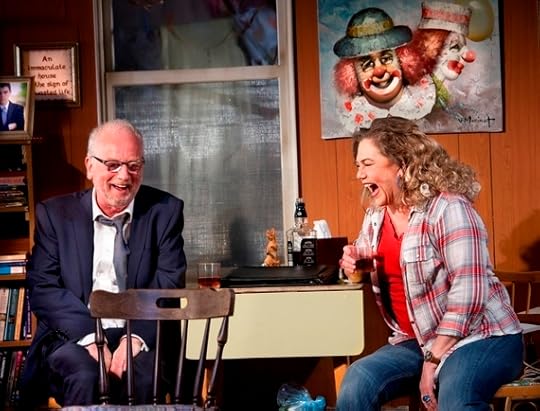
Bakersfield Mist is a short, fairly enjoyable play that battles clichés and unbelievable set-ups as it tries to make a point about art, education and the patronising exclusivity and arrogance of the art world.
Maude (Kathleen Turner) is a trailer park mom on the West Coast of the States desperately trying to convince Lionel (Ian McDiarmid), an educated, English art dealer who has just flown in on a private jet from New York, that a painting she picked up for three bucks in a thrift store is a Jackson Pollack masterpiece.
You have to suspend quite a bit of disbelief in the set-up - that such an esteemed art dealer would make such a trip himself - and frustratingly you have to keep suspending disbelief all the way through.
Lionel - arrogant and aloof - is savouring his opportunity to belittle Maude, a woman he considers beneath him in terms of class and education, by declaring her painting a fake. "Proving forgeries is a personal crusade of mine" he declares on meeting Maude, with almost palpable relish.
But though Maude may be out of her depths in the art world, she is a survivor and she will do whatever it takes to get to prove to her visitor that what she believes is the truth.
In reality, Lionel would've taken one look at the painting, declared it a fake and left (assuming that he would have made the trip at all). But here we have to go with it as Maude coerces Lionel to remain, gets him roaringly drunk in a matter of minutes on whisky she nicked from the bar she just got fired from, and sets about trying to persuade him of the painting's authenticity by any means possible.
Kathleen Turner and Ian McDiarmid are stars, obviously, and there is some entertainment in seeing these big names battling for intellectual and moral superiority in the cramped confines of Maude's trailer park home. However they are hampered by Stephen Sachs' writing which adds more incredulity with every turn - Maude attempting to seduce Lionel being an almost out-of-character moment.
Nevertheless the actors do their best. McDiarmid goes for more physical comedy as he gets more and more drunk to try and make it believable that he would open up so quickly to Maude. It's an understandable approach even though it can get a bit OTT.
Kathleen Turner works to bring integrity and dignity to Maude where perhaps the set-up might reduce her to a stereotype.
The highlight of the production for me was a superb set design from Tom Piper. Maude's trailer park home is crammed full of every type of junk and tacky bric-a-brac cliché possible. The home is almost a character in itself and it adds to the prejudices about this woman, how could she possibly know anything about real art?
But that of course is the point. Stephen Sachs' writing touches on a lot - the value of art, the emotions of creativity, the empathy for artistic expression, even class and life itself. If we have felt pain and suffering, as well as joy and happiness in life, then surely we have enough to understand emotion in art? Do we need to be educated to appreciate art?
All these questions are left unresolved and we are left with an open book of questions that goes far beyond whether the specific painting is a genuine Pollack. These are subjects that would have been more interesting if the premise hadn't been so forced.
This play ends rather abruptly, which may not be a surprise given that the set-up is so awkward, at a short 75 minutes. But given that top-price tickets are retailing for up to £85, it's questionable whether this show gives value for money.
However if you are keen to see these two big names and have flexibility in which dates you can attend, you can find tickets discounted to more affordable rates at the Love Theatre website and at the Leicester Square half-price ticket booth.
Duchess Theatre, London to August 30, 2014
Image credits: Kathleen Turner and Ian McDiarmid © Simon Annand
Published on May 28, 2014 04:53
May 19, 2014
Renaissance Impressions: Chiaroscuro Woodcuts Exhibition, Royal Academy of Arts
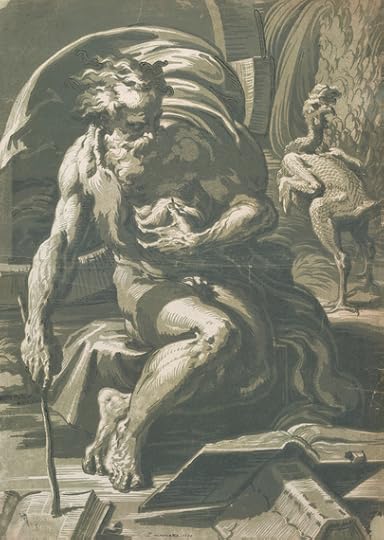
London has some big art shows open right now. The Royal Academy's exhibition on the development of woodcuts during the Renaissance period may not be a blockbuster to rival Matisse and Veronese but this is a surprisingly enjoyable as well as informative exhibition on the genesis and development of this technique.
Chiaroscuro woodcuts were a printing technique that originated in about 1500. Created by German inventors Lucas Cranach the Elder and Hans Burgkmair the Elder, these woodcuts were the first colour prints that made dramatic use of light and shadow - chiaroscuro - to suggest form, volume and depth.
You'd expect woodcuts to be quite dry, with the images rigid and lacking in artistic expression but not at all. The technical expertise in the 150 prints the RA has brought together is such that there is great detail in these prints with bodies outlined in curving sculpting lines, and cross-hatchings used for shadow.
The woodblocks were also cut to bring out detail as fine and specific as feathers on a cherub's wing, blades of grass and even the bark of Jesus' cross, as in Wechtlin's Christ on the Cross (1510-1512).
These woodcuts were also developed so that attributes of the paper being used for the print would be taken into account with paper colour and material considered to accentuate elements of the image, such as highlighting parts of the landscape or emphasising muscles to the human form.
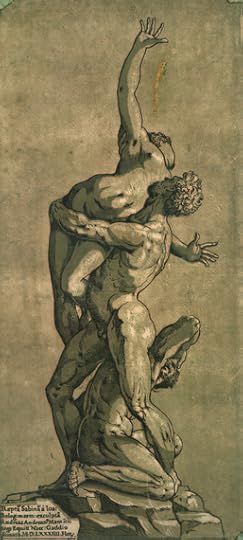
Characteristically for the Renaissance period, the subject matter of these woodcuts is all biblical stories and mythology.
And the influence of the major Renaissance artists can also be seen in the strong muscular physiques, reminiscent of Michelangelo, in compositions such as Goltzius' Hercules killing Cacus (1588) and Andrea Andreani's Rape of a Sabine Woman (1584).
More direct representations of Renaissance artists' works include Ugo da Carpi's woodcut The Death of Ananias (1518), which is a drawing based on one of Raphael's designs for the tapestries in the Sistine Chapel.
With an interesting foreshadow to the work of many contemporary works, artists took advantage of this new mass reproduction technique to reprint the same image in a variety of colourways. This has a great effect when the different versions are brought together such as the three versions of Ugo da Carpi's Diogenes (1527) and three versions of Antonio da Trento's Narcissus (1527-30).
Artists were also not limited by scale. Though many of the images on display are from a single woodcut block, there are a few where a number of blocks were used.
Amongst the largest are Andreani's The Lamentation of Christ (1593) which was printed from four sets of four blocks across 13 sheets of paper, and Andreani's The Sacrifice of Isaac (1586) - a single image created by five sets of four blocks.
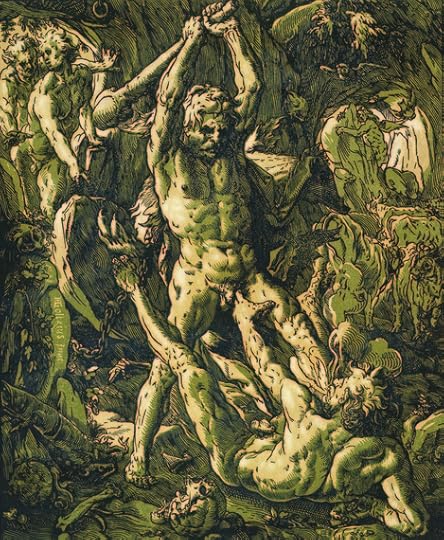
This exhibition may lack the box office draw of Matisse or Veronese but for those interested in art history and the creative process, it's well worth it.
Also, if you're thinking of going but a bit tentative on the subject matter, consider going along on the evening of Friday June 6th. Professor Mary Beard (in her role as the RA's Professor of Ancient Literature) is giving an evening talk exploring some of the classical themes from the exhibition from the rape of the Sabines to the tragic Narcissus (advance booking recommended).
Royal Academy of Arts, London to June 8, 2014
General Admission: £10 (concessions available)
Professor Mary Beard Evening Event Admission: £16 (concessions available) includes exhibition entry.
Image credits, with kind permission from the Royal Academy of Arts:
1. Ugo da Carpi, Diogenes, early sixteenth century, Chiaroscuro woodcut; four blocks (green and blue); first state 47.8 x 34.3 cm, Private Collection, Photo Albertina, Vienna
2. Andrea Andreani, after Giambologna Rape of a Sabine Woman, 1584 Chiaroscuro woodcut printed from four blocks, the tone blocks in brown, 44.7 x 20.9 cm Collection Georg Baselitz Photo Albertina, Vienna
3. Hendrick Goltzius Hercules Killing Cacus, 1588 Chiaroscuro woodcut printed from three blocks, the tone blocks in yellow and green, 41.1 x 33.3 cm Collection Georg Baselitz Photo Albertina, Vienna
Published on May 19, 2014 11:52
May 15, 2014
Fiona Shaw in 'The Testament of Mary', Barbican Centre
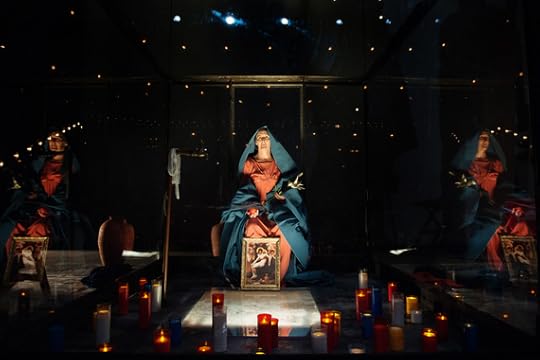
The Testament of Mary is quite something. Dramatic, moving and beautifully acted by Fiona Shaw, it is unequivocally one of the best shows in town right now.
Based on the Man Booker Prize-nominated novella by Colm Toibin, it is the story of the last few weeks of Jesus' life but through the eyes of the woman muted in all versions of the story - his mother.
In this play she is finally given a voice and what we see is the grief and anger of a mother who has witnessed the violent death of a son she was increasingly alienated from but never stopped loving.
The play begins with Mary as we recognise her, as the Virgin - a static mute symbol of motherly perfection draped in pale blue and surrounded by candles.
The audience is encouraged to get up close to the living statue as Shaw sits motionless within a glass display on the stage. I declined. There was too much of a scrum around her, too unseemly for comfort, but that I suspect was the point. How we have dehumanised her. In that respect, this is a very clever introduction.
The audience are soon returned to their seats, the glass display is lifted, Shaw's Mary discards the robes of her iconic image and reveals the woman she really is - complicated, angry and a firm non-believer.
"They want to make what happened live forever."
And with these angry, resentful first words Mary sets the tone for her version of events, how her son's followers have perverted the truth, misrepresented events, to fulfil a legacy and create a new world order that not only is untruthful but has robbed her of a son not only in life, but now in death.
Mary's cynicism is profound. She sneers at her son's followers, derisively referring to them as "misfits." She doubts all claims of miracles. Even when her friends Martha and Mary claim her son has raised their brother Lazarus from the dead, she remains unconvinced, again and again asking them what they actually saw and whether Lazarus was even dead.
There are no other characters on stage, no other actors in this play. Instead we, the audience, act as Mary's confidantes as she unravels in front of us.
Prostrate with grief, Mary wrestles with her conscience. Could she have stopped it? Why did her son reject her? And, worst of all, Mary confesses she abandoned her son when he needed her most. With him dying on the cross, Mary and his followers were forced to flee from the authorities, leaving her son to die alone with no mother to comfort him.
Shaw is so wracked with grief as she confesses this failure for which she will never forgive herself that you are quite moved.
The emotional balance in the writing is superb. Yes, this is a story of a pain we may understand though we will never experience but it is balanced with a few light moments.
Mary's reaction to being informed by one of her son's disciples that she had an immaculate conception is a stand-out moment, as is her observation of the "miracle" of water into wine at the wedding in Cana, an event she witnessed.
There is great depth and variety in the direction from Deborah Warner (who has collaborated many times with Shaw). The set is sparse and the story sorrowful but as Mary describes the people who've infiltrated her life, from the living dead of Lazarus to the eyes and ears of the State who warn her of her son's fate, you feel the stage come alive, filled with these characters.
It's Fiona Shaw that is the heart and soul of this production. She gives everything and her performance really moves you. The pain and anguish as she recounts these final days, these pressures, is betrayed in physical self-flagellation. Mary cannot help but take herself apart, such is the grief and guilt she is consumed with.
Such is the intensity of Fiona Shaw's performance that perhaps elements of the sound design could have been toned down a bit. Occasionally, as the tension and the self-abuse builds up, a burst of deafening white noise will crackle across the auditorium. It feels a bit OTT, as if the team are hammering a walnut. There's plenty enough in the performance without it being over-emphasised like this.
Yet this is a small niggle in what is a tremendous production.
At the end you are left watching a woman hunted by authorities determined to rid the state of accomplices yet clamoured for by others as an embodiment of a new religion that she rejects completely. Mary is an empty shell - a mother who will live the rest of her days with a guilt she will never be reconciled with.
The Testament of Mary is only on until the end of the month - a short run - but I recommend it unequivocally. It moved me to the core and its many messages and questions resonate with you long after you leave the theatre.
Barbican Centre, London to May 25, 2014
Image credits: Photo by Hugo Glendinning (c) Barbican Centre, London
Published on May 15, 2014 15:59
May 11, 2014
It's Tough Being a Feminist on Twitter
Over the weekend Caroline Criado-Perez has taken to Twitter in response to discovering an unannounced change in how abuse is reported on the social media site.
Sadly the campaigner was targeted again by misogynistic trolls and took to the usual route of escalating abuse for Twitter to investigate. Only as she did, she realised that the previous method of creating an auto-link to the abusive tweet (therefore preventing the reporter having to constantly view the message) has been removed.
Now, sadly, I've learnt nothing new from this as I have already suffered at the hands of this change in Twitter functionality. It was on Tuesday 22 April and the big news story that morning was Josie Cunningham.
As we know, Josie Cunningham was subject to a lot of abuse for her comments that she was considering having a termination for the sake of her career. I got involved and in response to my support of Josie Cunningham's right to choose, a man I did not know sent me a YouTube of an aborted foetus allegedly still alive.
Even three weeks later I still have to take a pause when I write that.
What a world we live in.
Let's rewind a bit here. To be honest, I still don't really know who Josie Cunningham is (I don't read the Daily Mail or gossip magazines) and prior to this story I'd never heard of her. Nevertheless I was gobsmacked and appalled at the amount of hateful judgment I read on Twitter that was aimed in her direction - even from people who claimed to be feminists.
I can't even be bothered to get into the politics of this - I don't have the patience. A woman's body, a woman's choice - it really is that simple. Pro-choice doesn't come with strings attached. Instead please can I refer you to two far better written pieces on this such as this one on The Guardian and this (perfectly put) blog from Louise Pennington.
These though hadn't been written on the Tuesday morning when I decided to stand up and be counted. I hate seeing women being bullied and shamed, I hate it. The Rant Mistress had just written a blog on this, a damn excellent piece, which got retweeted into my timeline.
I tweeted out my own link to this blog saying "I completely agree with this blog on Josie Cunningham. Her body, her choice #prochoice"
And the response I got? Violent, vicious misogyny.
Reporting it has been hell. When Twitter says it takes graphic abuse like this seriously, they're lying. It's incredibly difficult to report abuse like that, nor does Twitter give a damn about how traumatic it is to do.
As Caroline Criado-Perez has also found, there's no Report Abuse functionality or button such as Block or Report Spam. Instead you have to fill out an online form but in the form you have to attach the URL of the offending image. Which means you can't initially block the sender, allowing them to keep sending you abuse.
And unfortunately the URL Twitter wants included on the form is one embedded in the image, not the one in the search bar.
Which meant I had to open up this god-awful image again and again to find the right URL to send to Twitter. I desperately held my shaking left hand over the bloodied red image as I tried again and again to get the full URL copy and pasted using just my right thumb and forefinger. It's a five minutes of my life I never, ever, ever want to relive again.
The thing with online abuse like this - so graphic, so violent - is, well, it's hard to explain unless you've experienced it. You think you're ready for it, that you know it's part of the territory. But it still shocks you. I always thought violent misogynistic trolling was reserved for famous or important people leading campaigns, not inconsequential bloggers like me.
These guys get off on the violence, I know that. To them, it's like they've actually punched me in the face, kicked me in the stomach. You can't show it, you know you can't. But you do stumble, you do need support.
Yet the silence from Twitter has been deafening. I reported my abuser to Twitter on 23 April. I'm still waiting for a response.
Abuse is a silencing technique. Using violent imagery is abuse. Feminism loses the day we let the abuse and the hurt silence us. But it's not easy and it's frightening the extent to which Twitter refuses to recognise abuse as something they need to take action on.
And to the man who sent me this abuse, you haven't changed my politics and you never will.
Sadly the campaigner was targeted again by misogynistic trolls and took to the usual route of escalating abuse for Twitter to investigate. Only as she did, she realised that the previous method of creating an auto-link to the abusive tweet (therefore preventing the reporter having to constantly view the message) has been removed.
Now, sadly, I've learnt nothing new from this as I have already suffered at the hands of this change in Twitter functionality. It was on Tuesday 22 April and the big news story that morning was Josie Cunningham.
As we know, Josie Cunningham was subject to a lot of abuse for her comments that she was considering having a termination for the sake of her career. I got involved and in response to my support of Josie Cunningham's right to choose, a man I did not know sent me a YouTube of an aborted foetus allegedly still alive.
Even three weeks later I still have to take a pause when I write that.
What a world we live in.
Let's rewind a bit here. To be honest, I still don't really know who Josie Cunningham is (I don't read the Daily Mail or gossip magazines) and prior to this story I'd never heard of her. Nevertheless I was gobsmacked and appalled at the amount of hateful judgment I read on Twitter that was aimed in her direction - even from people who claimed to be feminists.
I can't even be bothered to get into the politics of this - I don't have the patience. A woman's body, a woman's choice - it really is that simple. Pro-choice doesn't come with strings attached. Instead please can I refer you to two far better written pieces on this such as this one on The Guardian and this (perfectly put) blog from Louise Pennington.
These though hadn't been written on the Tuesday morning when I decided to stand up and be counted. I hate seeing women being bullied and shamed, I hate it. The Rant Mistress had just written a blog on this, a damn excellent piece, which got retweeted into my timeline.
I tweeted out my own link to this blog saying "I completely agree with this blog on Josie Cunningham. Her body, her choice #prochoice"
And the response I got? Violent, vicious misogyny.
Reporting it has been hell. When Twitter says it takes graphic abuse like this seriously, they're lying. It's incredibly difficult to report abuse like that, nor does Twitter give a damn about how traumatic it is to do.
As Caroline Criado-Perez has also found, there's no Report Abuse functionality or button such as Block or Report Spam. Instead you have to fill out an online form but in the form you have to attach the URL of the offending image. Which means you can't initially block the sender, allowing them to keep sending you abuse.
And unfortunately the URL Twitter wants included on the form is one embedded in the image, not the one in the search bar.
Which meant I had to open up this god-awful image again and again to find the right URL to send to Twitter. I desperately held my shaking left hand over the bloodied red image as I tried again and again to get the full URL copy and pasted using just my right thumb and forefinger. It's a five minutes of my life I never, ever, ever want to relive again.
The thing with online abuse like this - so graphic, so violent - is, well, it's hard to explain unless you've experienced it. You think you're ready for it, that you know it's part of the territory. But it still shocks you. I always thought violent misogynistic trolling was reserved for famous or important people leading campaigns, not inconsequential bloggers like me.
These guys get off on the violence, I know that. To them, it's like they've actually punched me in the face, kicked me in the stomach. You can't show it, you know you can't. But you do stumble, you do need support.
Yet the silence from Twitter has been deafening. I reported my abuser to Twitter on 23 April. I'm still waiting for a response.
Abuse is a silencing technique. Using violent imagery is abuse. Feminism loses the day we let the abuse and the hurt silence us. But it's not easy and it's frightening the extent to which Twitter refuses to recognise abuse as something they need to take action on.
And to the man who sent me this abuse, you haven't changed my politics and you never will.
Published on May 11, 2014 16:00
May 5, 2014
Wonderful Matisse Exhibition at the Tate Modern
Tate Modern's major exhibition, Henri Matisse: The Cut-Outs, is the most comprehensive exhibition ever devoted to the artist's paper cut-outs. It brings together around 130 works, many seen together for the first time, in a ground-breaking reassessment of Matisse's colourful and innovative final works.
This exhibition is box-office gold and that is reflected in the crowds that fill the galleries at busy periods, such as Friday early evening when I went. But don't let that dissuade you - this once-in-a-lifetime show is well worth the effort. And the exhibition is so large that you will soon find space to enjoy the art in your own time.
The cut-outs - figures and forms cut from paper - were originally only used by Matisse in planning the composition for his paintings. But a combination of illness and old age, mixed with a curiosity about the cut-outs themselves, led Matisse to develop this process into an art form in its own right.
It's a credit to this exhibition that it makes a real effort to explain Matisse's creative process.
Archive footage of Matisse creating some of these works is projected onto a couple of the walls. Matisse worked fast. Holding the sheet of paper in one hand, he would cut the scissors quickly and decisively through the paper with the other, without conscious consideration, just letting the form, the figure, materialise from his impulses.
Matisse would also live with the murals for some time - often literally. He would pin the pieces on to the walls in his house, even in his bedroom, readjusting them, moving them, playing with the composition until he was happy with the results.
And the results are phenomenal.
Initially Matisse started small, using cut outs to create just 20 images to accompany Jazz, a book of poetry published in 1947. All those 20 images and the text is included in this exhibition and includes such gems as Icarus and The Horse, The Rider and The Clown.
But when Matisse found the confidence to explore the potential of cut-outs, the size of the final works became enormous.
To stand in front of something like Oceania, The Sky with cut-outs of birds, fish, coral and leaves all flowing together in a seamless world, or The Parakeet and the Mermaid with the two central figures swamped by fruit and algae, is quite wonderful.
A real draw to the exhibition is the Blue Nudes - the largest number of Matisse's Blue Nudes ever exhibited together, including the most significant of the group Blue Nude I. These giant, elegant figures are hung together in a single room and the effect is wonderful. They are beautiful. As well as their strong outlines, definition and contours have been carved into them through the cut-out process.
That Matisse continued to challenge himself at such a late stage in his career (he was in his seventies at this point) is quite remarkable. And he continued to investigate this new method.
He was approached by the Dominican Chapel of the Rosary in Venice to give advice on stained glass window yet he took this opportunity to create a scheme for the whole chapel. Here he was able to investigate how cut-outs could be used to create the foundation for stained glass window designs.
The finished result, a mosaic-style approach which captured the spirit of the religious experience without being confined by traditional religious imagery, Matisse considered to be "the result of all my active life."
I've only ever seen Matisse's cut-outs before in isolation - a piece here, a piece there. As a result I've not really fully understood their allure and some of the pieces have left me cold, such as The Snail, a mainstay of the Tate's permanent collection (also on show here).
Yet here, with the pieces brought together again, you finally appreciate what Matisse was achieving. To stand in front of these huge colourful compositions is a wonderful experience. Most definitely worth battling through the crowds for.
Tate Modern London to September 7, 2014
Admission: £18 (concessions available)
This exhibition is box-office gold and that is reflected in the crowds that fill the galleries at busy periods, such as Friday early evening when I went. But don't let that dissuade you - this once-in-a-lifetime show is well worth the effort. And the exhibition is so large that you will soon find space to enjoy the art in your own time.
The cut-outs - figures and forms cut from paper - were originally only used by Matisse in planning the composition for his paintings. But a combination of illness and old age, mixed with a curiosity about the cut-outs themselves, led Matisse to develop this process into an art form in its own right.
It's a credit to this exhibition that it makes a real effort to explain Matisse's creative process.
Archive footage of Matisse creating some of these works is projected onto a couple of the walls. Matisse worked fast. Holding the sheet of paper in one hand, he would cut the scissors quickly and decisively through the paper with the other, without conscious consideration, just letting the form, the figure, materialise from his impulses.
Matisse would also live with the murals for some time - often literally. He would pin the pieces on to the walls in his house, even in his bedroom, readjusting them, moving them, playing with the composition until he was happy with the results.
And the results are phenomenal.
Initially Matisse started small, using cut outs to create just 20 images to accompany Jazz, a book of poetry published in 1947. All those 20 images and the text is included in this exhibition and includes such gems as Icarus and The Horse, The Rider and The Clown.
But when Matisse found the confidence to explore the potential of cut-outs, the size of the final works became enormous.
To stand in front of something like Oceania, The Sky with cut-outs of birds, fish, coral and leaves all flowing together in a seamless world, or The Parakeet and the Mermaid with the two central figures swamped by fruit and algae, is quite wonderful.
A real draw to the exhibition is the Blue Nudes - the largest number of Matisse's Blue Nudes ever exhibited together, including the most significant of the group Blue Nude I. These giant, elegant figures are hung together in a single room and the effect is wonderful. They are beautiful. As well as their strong outlines, definition and contours have been carved into them through the cut-out process.
That Matisse continued to challenge himself at such a late stage in his career (he was in his seventies at this point) is quite remarkable. And he continued to investigate this new method.
He was approached by the Dominican Chapel of the Rosary in Venice to give advice on stained glass window yet he took this opportunity to create a scheme for the whole chapel. Here he was able to investigate how cut-outs could be used to create the foundation for stained glass window designs.
The finished result, a mosaic-style approach which captured the spirit of the religious experience without being confined by traditional religious imagery, Matisse considered to be "the result of all my active life."
I've only ever seen Matisse's cut-outs before in isolation - a piece here, a piece there. As a result I've not really fully understood their allure and some of the pieces have left me cold, such as The Snail, a mainstay of the Tate's permanent collection (also on show here).
Yet here, with the pieces brought together again, you finally appreciate what Matisse was achieving. To stand in front of these huge colourful compositions is a wonderful experience. Most definitely worth battling through the crowds for.
Tate Modern London to September 7, 2014
Admission: £18 (concessions available)
Published on May 05, 2014 06:36



